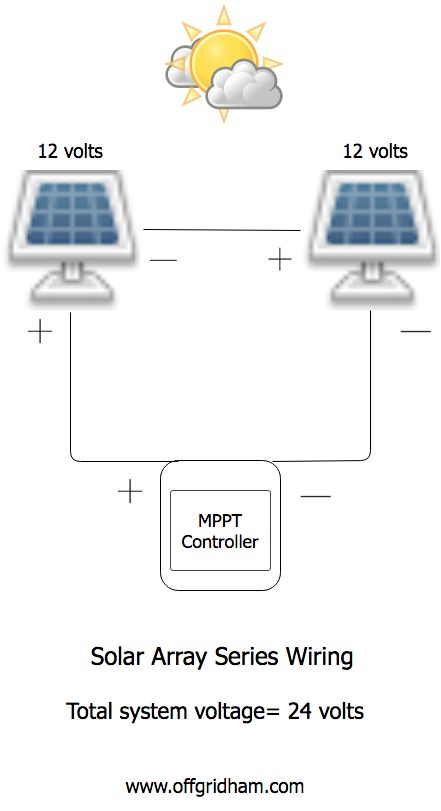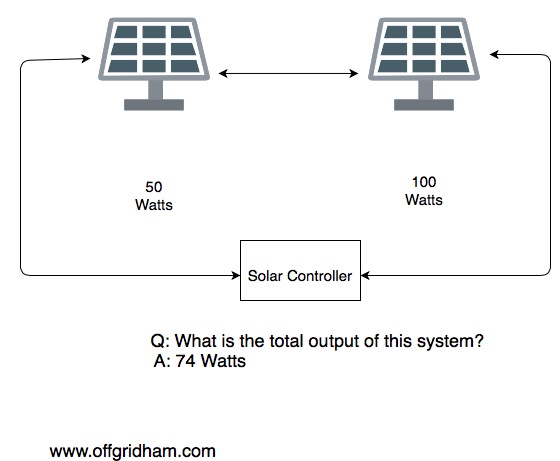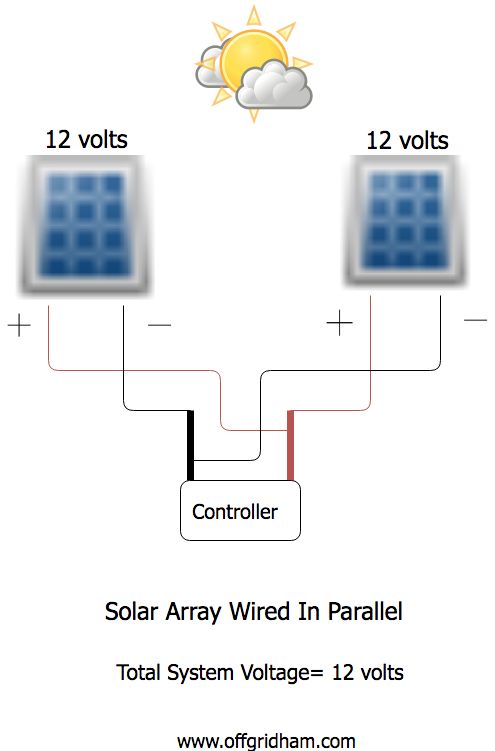So you’ve had your fun with small single solar panels and are ready for a larger multi-panel system that can handle beefier loads. Hopefully you’ve read previous Off Grid Ham articles and have your system all planned & spec’d out. There’s one important detail we haven’t covered on this blog before: How should you configure your solar array? A solar array can be wired in series or in parallel. We’ll go over both and help you make the best choice for your situation.
What’s the big deal?
It may seem like an article on how to plug in a solar panel is over explaining a simple concept, but stay with me on this one. The physical act of hooking up a solar array actually is simple. But do you know the pros and cons of the two main methods? Is one method better than another? Why are you doing it that way? Just plugging stuff in will get the job done but it’s not necessarily instructive. We’re here to address the why, not the how.
Panels in series.
Wiring your solar array in series increases the voltage to the sum of all the panels. The current will go down, which means you can push more power through the same size wire (more on this in a moment). This makes for better efficiency, but an MPPT charge controller is required to convert your solar array voltage to 12 volts on your battery. The maximum voltage output of your solar array is limited only to what your controller can handle. Connecting the panels is very straightforward. Simply plug the positive of one panel to the negative of another and chain them together.
Solar Array series wiring:
Pros:
- Usually uses less wire, depending on physical layout.
- Can use smaller gauge wire for the same wattage vs. parallel wiring.
- Preferred method for long wire runs between the controller and the panels.
Cons:
- A (more expensive) MPPT controller is required.
- Mixing different capacity panels will reduce total wattage output.
- A failure at any point in the series will shut the entire system down.
In it for the long haul.
DC power is inherently “lossy” compared to AC power when sent down a long wire. Bumping the voltage up by wiring your solar array in series will minimize the loss if the wire run between the panels and the controller is particularly long.
For example: A fifty foot 8 gauge wire with 48 volts DC at 4 amps (192 watts) will lose 0.25 volts or 0.52% over the run. The same wire with 12 volts at 16 amps (still 192 watts) will lose 1.01 volts or 8.38% over the same run! This copper wire loss calculator is a quick and easy way to see the real effect of running your solar array at different voltages.
Which is better: Losing 0.25 volts from a total of 48, or losing 1.01 volts from a total of 12? You don’t need an engineering degree to see the advantage of running your solar array at a higher voltage.
Can I wire mismatched panels in series?
The short answer is yes, but there’s a huge catch. Mixing solar panels of different capacities in a series array is going to have some very negative effects. Suppose you have a 50 watt panel and 100 watt panel wired together in series. At first glance it may seem the total system capacity is 150 watts. It doesn’t work that way.
The maximum current running though your series solar array will never be higher than the lowest capacity panel. This will not damage anything and it will technically work, but you are seriously hobbling your system.
Let’s look at an example using real world specifications from solar panels that are on the market right now: Panel A is 50 watts at 12 volts, with a maximum current of 2.85 amps. Panel B is 100 watts at 12 volts, with a maximum current of 5.81 amps. Since these are wired in series, the system voltage is 24 volts (in reality it’s around 26 volts). The current in the system will never exceed 2.85 amps because that’s as much as the smallest panel can do, so the total system capacity will be 74 watts (26 x 2.85= 74.1). Think of it like ships in a sea convoy. They must stay together as a group thus the entire group can only go as fast as the slowest ship.
In electronics, current will always be the same at all points in a series circuit, and in this example the 50 watt panel tops out at 2.78 amps. So that’s all the larger 100 watt panel will do too even though it is capable of more.
If you want to geek out with the theory and math behind this, read up on Kirchoff’s Current Law.
Panels in parallel.
Parallel wiring is the other method you may want to consider for your solar array. All the panels have to be the same voltage, but unlike series arrays they can be different wattage/current because each panel is its own independent circuit. You will probably want to terminate the positive and negative wires from each panel onto a common negative and positive bus and then feed it to the controller.
Solar Array parallel wiring.
Pros:
- Will work with mismatched panels as long as they are the same voltage (i.e., you can have a 50 and a 100 watt panel in the same array without wasting any energy producing potential).
- A failure in one branch/section will not bring the entire system down.
- Does not require an MPPT controller.
- Can expand system without reconfiguring controller or rearranging wiring on other panels.
Cons:
- Cannot raise system voltage to increase efficiency and take advantage of MPPT controller.
- Will probably require larger gauge/longer wiring depending on physical layout.
Built in backup plan.
One great advantage of the parallel wired solar array is that a failure in one branch will not disable the entire system. You will have reduced power, but at least you won’t be left completely without juice. In the diagram above, notice that a breakdown in either branch still leaves at least one panel with a complete circuit to the controller.
Another nice aspect is that expansion is as easy as adding another panel and terminating it on the bus. You do not have to change anything on your controller or break into the existing wiring.
What you need to know.
Knowing the why will help you determine the how. Series or parallel…there is no “correct” method, but you should go into it understanding the pros and cons of each and have a clear idea as to why you made your choices.
Correction: Edited to correct inaccurate information in graphic, December 2020.



Thanks Chris, more good information. I’ll be running on SLABs (5A and 9A) for Field Day, but alas, no solar. I’ll get that done later this summer. We’ve joined forces with another club, so I’m expecting to see good things. Your last post on Field Day was also good, as usual. Have fun on FD.
Hi Mike, my participation in Field Day will be somewhat limited due to a previous commitment, but I hope everyone else has a great weekend!
Great explanation of the differences between series and parallel connections. Offgridham has become the first place I tell people to go when they start asking me questions about solar and battery power for equipment.
— One question: Have you had issues with RFI from controllers and charging systems? I’ve been seeing a significant number of complaints from amateur radio websites over the last year or so about serious radio interference coming from some solar installations, especially the larger ones. Most of these RFI issues that I’ve been reading about seem more anecdotal than fact based, though. There are so many sources of interference out there that it’s possible new solar installations are being blamed simply because they’re so easily visible.
Hi Randall, thanks for the vote of confidence in sending others to Off Grid Ham. I’m very flattered and grateful.
As for interference, like you I’m not convinced the problem is as bad as it’s promoted to be. I personally have never had an issue and I’m off grid exclusively. About a year ago QST magazine had an cover story about RFI from solar, but the author wasn’t clear as to whether he was addressing a known issue or preemptively trying to avoid one. He certainly went though a lot of effort, time, and money, so I hope he wasn’t chasing a problem that didn’t exist.
Chris, I have a question. You say “Will work with mismatched panels as long as they are the same voltage”. I guess that this means 5V, 12V etc.
But don’t different quality/brand panels, give out different voltage too? In the sense of say, 13.2 and 13.6V.
What would the effect be then?
Hi Greek, you bring up a great point. “12 volt” solar panels aren’t really 12 volts. In strong sun they run much higher, sometimes as much as 21 volts unloaded. By the way, this also explains why the current/voltage/wattage numbers in the examples used in this article don’t exactly add up. Anyway, when you place a solar panel on a load, the voltage will drop closer to a “normal” level, and the charge controller will take care of any additional unresolved differences. To answer your question, there is a fairly wide tolerance so don’t sweat it if the panel voltages don’t exactly match.
I live full time in a mostly solar powered RV and have wired my panels at various times in both configurations. One important consideration I have found is shading. In series if one panel is shaded you lose all power (mostly). I have yet to see an RV that doesn’t have enough things sticking out to shade one of the panels at least some of the time. May not be a consideration if you are placing your panels out in the direct sun but if you have them mounted consider shading and I would say go with parallel wiring.